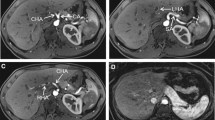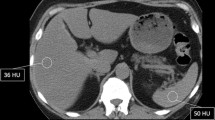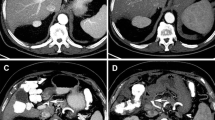Abstract
The purpose of this study was to determine whether MR angiography utilizing the time resolved echo-shared angiographic technique (TREAT) can provide an effective assessment of the hepatic artery (HA) and portal vein (PV) in living donor candidates. MR angiography (MRA)was performed in 27 patients (23 men and 4 women; mean age, 31 years) by using TREAT. Two blinded radiologists evaluated HA anatomy, origin of segment IV feeding artery and PV anatomy in consensus. Qualitative evaluations of MRA images were performed using the following criteria: (a) overall image quality, (b) presence of artifacts, and (c) degree of venous contamination of the arterial phase. Using intraoperative findings as a standard of reference, the accuracy for the HA anatomy, origin of segment IV feeding artery and PV anatomy on TREAT-MRA were 93% (25/27), 85% (23/27), and 96% (26/27), respectively. Overall image qualities were as follows: excellent (n=22, 81%), good (n=4, 15%), and fair (n=1, 4%). Significant artifacts or venous contamination of the arterial phase images was not noted in any patient. TREAT-MRA can provide a complete evaluation of HA and PV anatomy during preoperative evaluation of living liver donors. Furthermore, it provides a more detailed anatomy of the HA without venous contamination.




Similar content being viewed by others
References
Carr JC, Nemcek AA Jr, Abecassis M et al (2003) Preoperative evaluation of the entire hepatic vasculature in living liver donors with use of contrast-enhanced MR angiography and true fast imaging with steady-state precession. J Vasc Interv Radiol 14:441–449
Sahani D, D’Souza R, Kadavigere R et al (2004) Evaluation of living liver transplant donors: method for precise anatomic definition by using a dedicated contrast-enhanced MR imaging protocol. Radiographics 24:957–967
Van Hoe L, De Jaegere T, Bosmans H et al (2000) Breath-hold contrast-enhanced three-dimensional MR angiography of the abdomen: time-resolved imaging versus single-phase imaging. Radiology 214:149–156
Fink C, Ley S, Kroeker R, Requardt M, Kauczor HU, Bock M (2005) Time-resolved contrast-enhanced three-dimensional magnetic resonance angiography of the chest: combination of parallel imaging with view sharing (TREAT). Invest Radiol 40:40–48
Korosec FR, Frayne R, Grist TM, Mistretta CA (1996) Time-resolved contrast-enhanced 3D MR angiography. Magn Reson Med 36:345–351
Du J, Carroll TJ, Wagner HJ et al (2002) Time-resolved, undersampled projection reconstruction imaging for high-resolution CE-MRA of the distal runoff vessels. Magn Reson Med 48:516–522
Fink C, Puderbach M, Ley S, Zaporozhan J, Plathow C, Kauczor HU (2005) Time-resolved echo-shared parallel MRA of the lung: observer preference study of image quality in comparison with non-echo-shared sequences. Eur Radiol 15:2070–2074
Turski PA, Korosec FR, Carroll TJ, Willig DS, Grist TM, Mistretta CA (2001) Contrast-enhanced magnetic resonance angiography of the carotid bifurcation using the time-resolved imaging of contrast kinetics (TRICKS) technique. Top Magn Reson Imaging 12:175–181
Wieben O, Grist TM, Hany TF et al (2004) Time-resolved 3D MR angiography of the abdomen with a real-time system. Magn Reson Med 52:921–926
Michels NA (1966) Newer anatomy of the liver and its variant blood supply and collateral circulation. Am J Surg 112:337–347
Soyer P, Bluemke DA, Choti MA, Fishman EK (1995) Variations in the intrahepatic portions of the hepatic and portal veins: findings on helical CT scans during arterial portography. AJR Am J Roentgenol 164:103–108
Fink C, Bock M, Puderbach M, Schmahl A, Delorme S (2003) Partially parallel three-dimensional magnetic resonance imaging for the assessment of lung perfusion—initial results. Invest Radiol 38:482–488
Nael K, Laub G, Finn JP (2005) Three-dimensional contrast-enhanced MR angiography of the thoraco-abdominal vessels. Magn Reson Imaging Clin N Am 13:359–380
Lee VS, Morgan GR, Teperman LW et al (2001) MR imaging as the sole preoperative imaging modality for right hepatectomy: a prospective study of living adult-to-adult liver donor candidates. AJR Am J Roentgenol 176:1475–1482
Limanond P, Raman SS, Ghobrial RM, Busuttil RW, Saab S, Lu DS (2004) Preoperative imaging in adult-to-adult living related liver transplant donors: what surgeons want to know. J Comput Assist Tomogr 28:149–157
Author information
Authors and Affiliations
Corresponding author
Rights and permissions
About this article
Cite this article
Lee, M.W., Lee, J.M., Lee, J.Y. et al. Preoperative evaluation of hepatic arterial and portal venous anatomy using the time resolved echo-shared MR angiographic technique in living liver donors. Eur Radiol 17, 1074–1080 (2007). https://doi.org/10.1007/s00330-006-0447-3
Received:
Revised:
Accepted:
Published:
Issue Date:
DOI: https://doi.org/10.1007/s00330-006-0447-3




